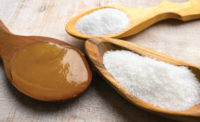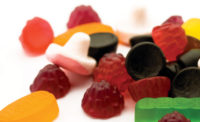When it comes to ingredients, simplicity and transparency can help build trust. We’ve seen this trend evolve in recent years: Consumers have become more critical about what they’re putting in their bodies and are pushing for more natural, clean-label ingredients.
According to the HealthFocus International Global Trend Study 2018, one in three consumers surveyed said they have increased their research on ingredients over the last year. And in a survey by FMCG Gurus, 67 percent of respondents said that “the fewer ingredients in a product, the better it is.” In the confectionery category, the story is no different.
“Artificial food additives are no longer a popular choice in sweet treats like candies, chocolate, ice cream and chewing gum,” says Steven Gumeny, regional product manager at BENEO. More and more confectionery launches use either natural or additive/preservative-free claims, or both.
This is one area in which starches can play. As an increasing number of confectionery companies move toward more natural and label-friendly launches, suppliers are taking note and creating alternatives to long-standing ingredients that consumers are starting to find less welcome in their food. It starts, of course, with the starches themselves.
According to Michelle Kozora, technical services manager, Cargill Texturizing Solutions, Cargill, consumer demands for clean-label products have caused food manufacturers to reconsider using modified food starches. In response, Cargill’s food scientists have been developing ways to replace modified food starches with native starches that are obtained from sources such as corn, wheat, potato, cassava and tapioca and can improve functionality.
“There is a lot of work going into developing label-friendly starches,” says Shiva Elayedath, senior technical services manager, Cargill. “There is also significant work going into improving the process tolerance of native starches using physical processes. This will enable developers to improve formulating while using label-friendly ingredients.”
Coming from different botanical sources, native starches are cost-effective processing aids that work particularly well as dusting agents or moulding starches in confectionery applications. But they can also provide coveted alternatives for ingredients that consumers want to see less of. Gelatin, which comes from animal sources and has long been used in gummies, is one of the major ingredients that starches could help phase out.
“We have not yet seen a native starch that can replace gelatin used in confectionery applications alone,” Kozora says. “However, we have had some success using small amounts of tapioca starch in combination with ingredients such as pectin and agar agar to develop a gel in sugar confections.”
It’s just one instance of starches working in combination with other ingredients to make advances in confectionery applications. According to Wen Shieh, technical leader for fruit, beverage and confections, Cargill Texturizing Solutions, Cargill, combining hydrocolloids with starch is an innovative development to create a unique texture and provide consumers with new eating experiences. And for those who aren’t opposed to gelatin in their gummies, combining it with starch can minimize the melting of those candies at higher storage temperatures.
All the work that has gone into developing native starches has brought about an assortment of options with versatile properties that make them applicable to a number of use cases.
Take, for example, BENEO’s Remy B7 native rice starch. It is a technical ingredient in confectionery because of unique properties and can be used in multiple areas of candy. Its tiny, granular size helps smooth rough surfaces on confectionery centers during the coating process, but its natural color provides a bright sheen of white to the outside of sugar-coated candies, tablets and gums. It brings texture and stability to items such as chocolate coatings, nut butter spreads and creamy fillings. For inclusions and sauces in frozen treats, rice starch can provide freeze-thaw stability. It can also mimic the creamy mouthfeel of fat for enhanced textures in reduced-fat applications.
“Test trials by BENEO have shown that rice starch is extremely stable and will preserve the brilliant white color of end products for months,” Gumeny says. “A perfect coating will not only have a brilliant color but a smooth surface as well. Due to its very fine particle size, the rice starch can fill up all the micro pores on the surface of coated candies. It therefore allows for the creation of perfectly smooth coatings.”
That so-called “smoothing effect” also has the added benefit of preventing cracking or splintering of edges during the drying process.
According to Gumeny, the fact that the confectionery industry is now taking notice of rice starch is an exciting development for BENEO. Although rice starch is commonly found in savory applications, its use in confection is relatively new. But, he says, it’s an effective clean-label solution that should lead to many new and improved products in the years to come.
For Elayedath, starch continues to be a critical ingredient in the development toolbox for food scientists. Not only does it offer an economical way to deliver excellent texture and stability over shelf life for many products, but it’s also an ingredient that consumers are familiar with and accept. In today’s label-conscious environment, that’s important. That acceptance gives starch plenty of room for further development and growth.
“The innovation pipeline for starches is strong with new botanical sources and functional native starches that are able to provide similar functionality to modified starches,” Elayedath says. “All this continues to keep starch relevant in the evolving food landscape.”











